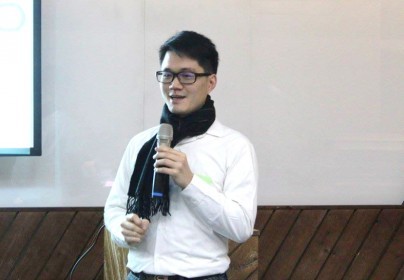Voltset talks about crowdfunding: How should we reward backers? Just ask them!
Translated by 半月
1. I am a sailor. I have my own boat.
2. I have been a maintenance worker since kindergarten. I have disassembled a tricycle and try to fix a problem.
3. I earned my first quarter by creating my own business when I was 6.
4. I have Arnold Schwarzenegger’s signature on my diploma.
“One of the above statement about me was false. Take a guess!” Said Tommy.
Tommy Wang, cofounder of Voltset Smart Multimeter, has been an active player in the community of business starters in Denmark, Copenhagen and California, USA. Besides that, he has also been a Maker for more than three decades and has worked as R&D Engineer for Agilent Technologies. Recently, he was invited to give a talk on “Makers on Crowdfunding, Are you ready?” to share his experiences.
First of all, let’s watch a video clip on Voltset Smart Multimeter:
“ When it comes to business, the only thing that matters is the value that you create. Doing things that you like is your hobby. However, this is not enough for starting a business. As we all know, crowdfunding has many perspectives, just like running a restaurant. We can discuss a variety of things like how to choose ingredients, how to cook the food, what the servers should wear and so on. Therefore, I will pick topics that I consider important to talk about.” Says Tommy.
“So, what IS value? It is what you can offer your clients within a minimum amount of time. As they say, time is money. ”
Choose the platform that fits your need
“Venture capital has been there in the silicon valley for a while. However, crowdfunding has developed in a even more impressive manner. In 2013, the total amount of money raised by crowdfunding was three times as much as traditional venture capital. Today, there are 36-40 fundraising platforms in the world. Among them, Kickstarter is a very successful one (though not the first). They use a ‘all or nothing’ system in which if the project creator did not reach their funding goal. The backers would take their money back. In other platforms, the project creator could get the amount the raised even they did not reach the funding goal in other platforms. 
“ As some of you might have noticed, Kickstarted made an announcement last year that their goal is to become a social enterprise. But that’s not what Indiegogo intends to do. On the other hand, Indiegogo is a platform designed for real buyers and sellers. Because of their differed goals, people who go on those platforms would differ as well. For example, backers on Kickstarter may be more tolerant to problems in fundraising proposals and help the project creatirs fix their problems.”
“Also, different fundraising platforms have different ways to categorize fundraising campaigns. By the way, on Kickstarter, you can even change category when your campaign is on. When choosing among platforms, think twice (or even more times) about what you want, where are your customers, and other wh- questions before you leap.»
Invest your research resource on people who pay
“ The battle starts from the homepage. But I once asked people who work for Kickstarter about how to make it onto the first page. They said that there are 2 factors: computer algorithm and manual selection. What does this actually mean? It means that don’t think too much. Just try to optimize our campaign!”

“ When raising funds for Voltset, we know exactly how to raise funds because we ourselves were exactly the target customers. We know what people would want to use or buy. For example, we put a picture of on the page. The customer immediately got the message we wanted to convey. Then, communication about further modification becomes easy. Thus, you have to reach first a small group of people. And make them fall in love with you!”
Tommy said, “In conventional fundraising, the first few angels are crucial for venture capital. In the story of crowdsourcing, things become even more interesting!”
“We made some primitive analysis on potential customers of our smart Multimeter. It turned out that customers could be categorized into three types. Type A customers think that this is too cool. They don’t care about how much it will cost and want every function possible. Type B customers consider it cool as well. However, they only want critical functions. They care about the price. Finally, other people just don’t find this product interesting. Based on these findings, we decided to put Voltset ($99, $79 for early birds) and Voltset Pro($119, $139 for early birds) in the fundraising campaign. Now, can you guess the results for these two lines of product when we started the campaign?”
“We thought that 75% of the money would go for Voltset, the cheaper version. However, the 200 sets of Voltset Pro were sold out immediately while there were still Voltsets left. Therefore, don’t blindly believe the analysis. It’s just part of your preparatory work. Only the people who pay will tell you the answer. In other words, you have to Make them pay.”
Coolest cooler did not get the ten-million-dollar fund at the first time
“There are many things in a successful campaign. You need an idea. You have to make it a product. After all these, you have to tell a good story. If the audience don’t get it, they will not buy it.” When asked about factors that cause an unsuccessful campaign, Tommy did not answer directly. “There are just too many reasons for a failed project. It could be the design. It could be insufficient money invested. It’s just like creating a business; there are just way too many ways to fail. However, I would like to share with you another thing.”
“Today, the record for the highest fundraising campaign on Kickstarter was set by the smart watch project Pebble1. But before Pebble, it was the Coolest cooler project that made the record.”
Coolest cooler is a portable icebox with a built-in mixer, a blue-tooth speaker and a USB port. In fall 2013, they made their debut on Kickstarter with a funding goal of 125,000 dollars. At the end of the campaign, they raised only a hundred thousand dollars.
“I still think it’s a good idea, but the market has spoken.” said the project creator Ryan Grepper.
He made some adjustment of his product and came back again in 2014. Within three days, the project raised a total amount of 13,285,226 US dollars from 62,642 backers.
“Everyone sees Coolest cooler’s success and their record breaking moment. However, they did not make it at the first time. The lessons they learnt from failure lead to their success!”
Well, as for the four statements of Tommy. We can see from the registration webpage that statement a. and b. are true. So, is he really a sailor or does he own Arnold’s signature? What do you think?
- In 2012, Pebble made its debut on Kickstarter and raised 10,266,845 US dollars. In 2015, they raised 20,338,986 US dollars with their second generation product line “Pebble Time”. Until today, this still is the highest fund raising project on Kickstarter.
中文版連結
Cover photo from PanX











留言討論